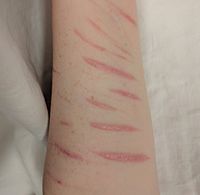
Photo from wikipedia
Low childhood income is an established risk factor of self-harm in adolescence and young adulthood, and childhood income is additionally associated with various correlates of self-harm. How these correlates, such… Click to show full abstract
Low childhood income is an established risk factor of self-harm in adolescence and young adulthood, and childhood income is additionally associated with various correlates of self-harm. How these correlates, such as psychiatric disorders, substance abuse, violent behaviour and school problems, mediate the effect of childhood income on self-harm, is less understood. The purpose of the current paper is to examine this mediation. The study is based on administrative register data on all Finnish children born in 1990–1995. An analytical sample of 384,121 children is followed from age 8 to 22. We apply the parametric g-formula to study the effect of childhood income on the risk of self-harm in young adulthood. Adolescent psychiatric disorders, substance abuse, prior self-harm, violent criminality and victimization, out-of-home placements, not being in education, employment or training and school performance are considered as potential mediators. We control for confounding factors related to childhood family characteristics. As a hypothetical intervention, we moved those in the lowest childhood income quintile to the second-lowest quintile, which resulted in a 7% reduction in hospital-presenting self-harm in young adulthood among those targeted by the intervention (2% reduction in the total population). 67% of the effect was mediated through the chosen mediators. The results indicate that increases in childhood material resources could protect from self-harm in young adulthood. Moreover, the large proportion of mediation suggests that targeted interventions for high-risk adolescents may be beneficial. To our knowledge, this is the first paper to use the parametric g-formula to study youth self-harm. Future applications are encouraged as the method offers several further opportunities for analysing the complex life course pathways to self-harm.
Journal Title: SSM - Population Health
Year Published: 2021
Link to full text (if available)
Share on Social Media: Sign Up to like & get
recommendations!